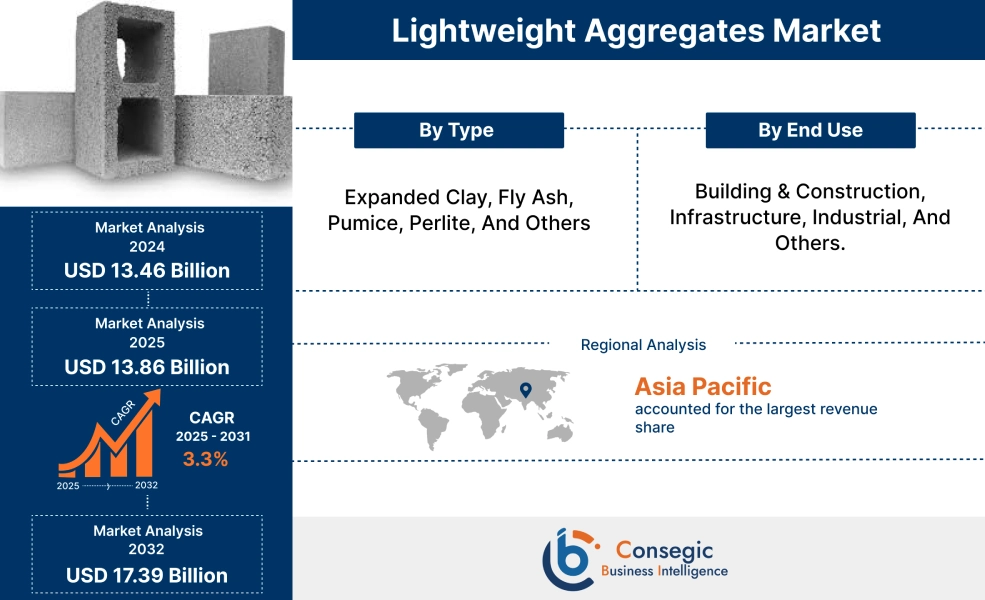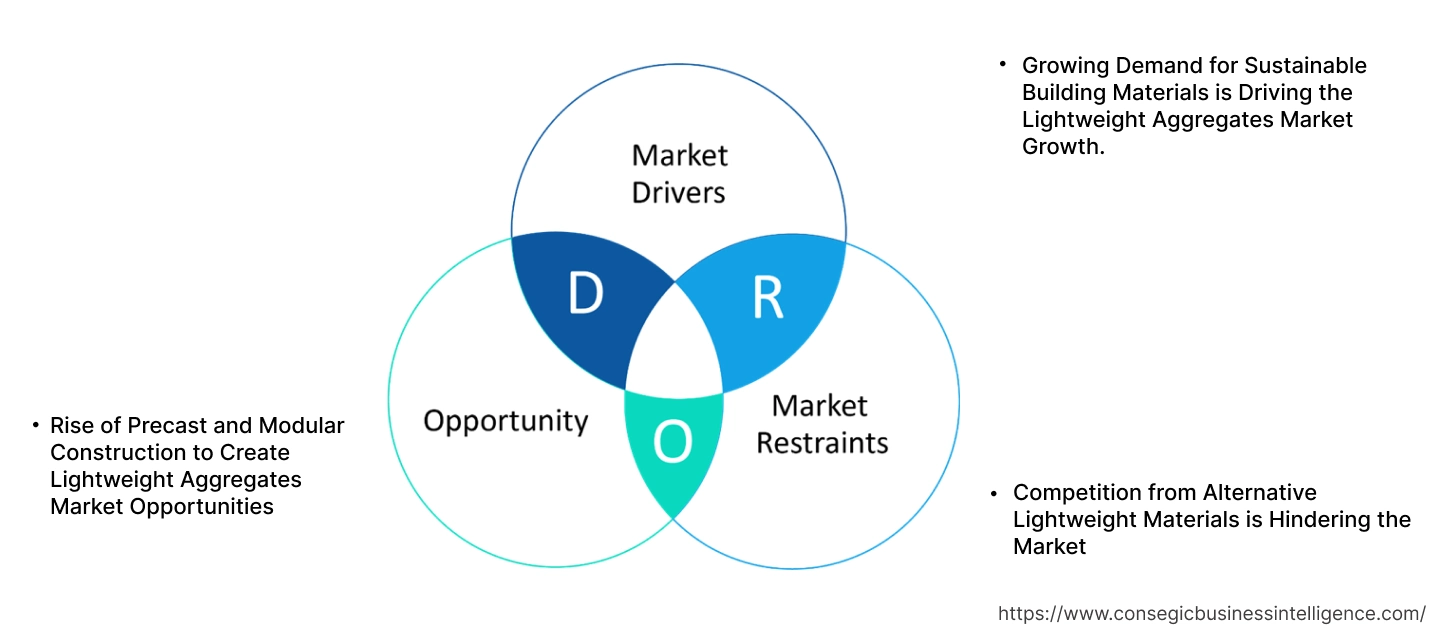Lightweight Aggregates Market Size:
The Lightweight Aggregates Market size is growing with a CAGR of 3.3% during the forecast period (2025-2032), and the market is projected to be valued at USD 17.39 Billion by 2032 from USD 13.46 Billion in 2024. Additionally, the market value for 2025 is attributed to USD 13.86 Billion.
Lightweight Aggregates Market Scope & Overview:
Lightweight aggregates are defined by their significantly lower density compared to conventional aggregates, due to its particle density less than in contrast to combination of particles in dry loose bulk, a primary feature it offers due to their porous internal structure. Their excellent thermal and acoustic insulation properties along with inherent fire resistance, make them a suitable option for energy-efficient and safer and smart buildings, aligning with the growing emphasis on sustainable construction practices and green building certifications. Additionally, the increasing adoption of precast and modular construction, alongside the need for improved seismic performance in structures, continues to fuel demand for such versatile materials in a wide array of applications.
How is AI Impacting the Lightweight Aggregates Market?
AI is improving the lightweight aggregates market by optimizing production with automation and AI-driven quality control, enhancing supply chain efficiency through predictive analytics for demand forecasting and inventory management. Additionally, the integration is driving sustainability with better resource use and traceability of materials. Further, AI-powered tools also help in developing innovative aggregates for diverse applications, from construction to agriculture, which in turn allow for data-driven decisions and product development.
Lightweight Aggregates Market Dynamics - (DRO) :
Key Drivers:
Growing Demand for Sustainable Building Materials is Driving the Lightweight Aggregates Market Growth.
The lightweight aggregate materials align with green building principles, offering benefits such as resource efficiency by utilizing industrial byproducts, thereby reducing waste and conserving virgin resources. Additionally, their thermal insulation properties contribute considerately to a building's energy efficiency, lowering operational carbon emissions.
- For instance, according to Manufacturing Today, the green building materials market experienced a growth rate of more than 10% in 2024 from 2023.
Hence, due to the aforementioned factors, growing demand for sustainable building materials is driving lightweight aggregates market growth.
Key Restraints:
Competition from Alternative Lightweight Materials is Hindering the Market.
Materials such as aerated autoclaved concrete (AAC) blocks, expanded polystyrene (EPS) concrete, foam concrete, and several other insulating foams are all competing for market share, offering similar advantages such as reduced weight, thermal insulation, and simpler handling. These alternatives sometimes present more competitive pricing, distinct installation benefits, or specialized performance tailored to specific uses, requiring the lightweight aggregates sector to innovate and maintain its value to retain and grow its position. Therefore, the above-mentioned factors are contributing to hindrances in the lightweight aggregates market expansion.
Future Opportunities :
Rise of Precast and Modular Construction to Create Lightweight Aggregates Market Opportunities.
The current modern construction methods prioritize off-site fabrication of building components in controlled factory environments, which are then transported and assembled on-site. Lightweight aggregates are suitable for this approach because they significantly reduce the weight of prefabricated building elements such as wall panels, floor slabs, and facade units. This weight reduction translates directly into easier and more cost-effective transportation, faster on-site assembly and expedited project completion times. A few of the pre-fabrication buildings include modular data centers and others.
- For instance, according to Kreo, the modular construction market is expected to grow by more than 6% CAGR from 2023 to 2030.
Thus, as per analysis, rise of precast and modular construction are expected to create lightweight aggregates market opportunities.
Lightweight Aggregates Market Segmental Analysis :
By Type:
Based on Type, the market is categorized into expanded clay, fly ash, pumice, perlite, and others.
Trends in Type:
- Expanded clay aggregates popularity is due to their balanced profile of properties including good mechanical strength, low density, and others.
The expanded clay segment accounted for the largest lightweight aggregates market share in 2024 and is expected to grow at the fastest CAGR over the forecast period.
- The expanded clay segment is prominent due to its well-established performance and remarkable versatility. It offers an excellent strength-to-weight ratio crucial for structural applications, superior thermal and acoustic insulation for energy efficiency, and inherent fire resistance for safety.
- Its utilization in various applications such as structural and insulating concrete, geotechnical fills and precast elements, amongst other further contribute its market position with a particular focus on green building practices and large-scale infrastructure projects expanding globally.
- For instance, according to the United Nations Human Settlements Program, LEED certification, one of the most preferred independent verifications of a building, certified more than 1.8 million sq ft of construction space on a daily basis.
- Thus, as per the market analysis, the expanded clay segment is dominating the lightweight aggregates market expansion.
By End-Use:
Based on the End Use, the market is building & construction, infrastructure, industrial, and others.
Trends in the End Use
- Increasing demand for residential and commercial spaces globally, particularly in emerging economies of Asia Pacific are contributing to construction industry activities.
- The growing investment in upgrading and developing new infrastructure, including roads, bridges, railways, ports, and tunnels is a trend positively impacting the market.
The building & construction segment accounted for the largest market share of 48.66% in 2024.
- The building & construction industry is dominant due to the wide utilization of lightweight aggregates within both residential and commercial construction.
- This is driven by population growth, increasing global urbanization, and an increasing demand for new structures.
- The materials' ability to reduce structural dead load in high-rise buildings and enhance thermal insulation for energy efficiency are driven by green building mandate. Moreover, it facilitates faster precast and modular construction, further contributing to modern building practices.
- Thus, based on the market analysis, the building & construction segment dominate lightweight aggregates market demand.
The infrastructure segment is expected to grow at the fastest CAGR over the forecast period.
- The infrastructure segment is experiencing accelerated growth due to the increasing worldwide investments in modernizing and expanding infrastructure, including roads, bridges, railways, and tunnels.
- Lightweight aggregates are important for reducing dead loads, enhancing seismic performance, improving durability, and providing critical operational efficiencies for large-scale projects.
- Additionally, the trend of sustainable and resilient infrastructure further solidifies the segment revenue.
- For instance, according IBEF, the capex of overall infrastructure in India is expected to grow by more than 11% by 2026.
- Thus, as per the lightweight aggregates market analysis, the infrastructure segment is dominating the lightweight aggregates market demand.
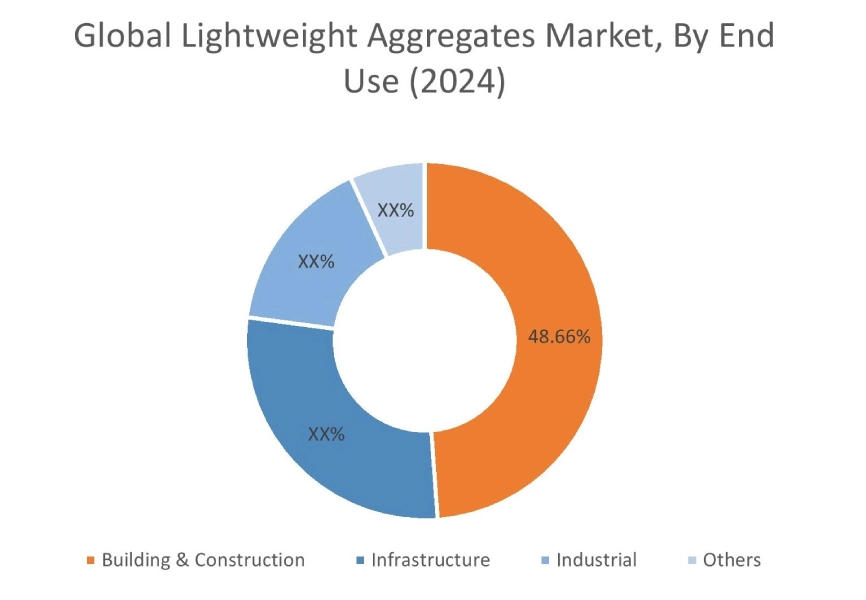
Regional Analysis:
The regional segment includes North America, Europe, Asia Pacific, the Middle East and Africa, and Latin America.
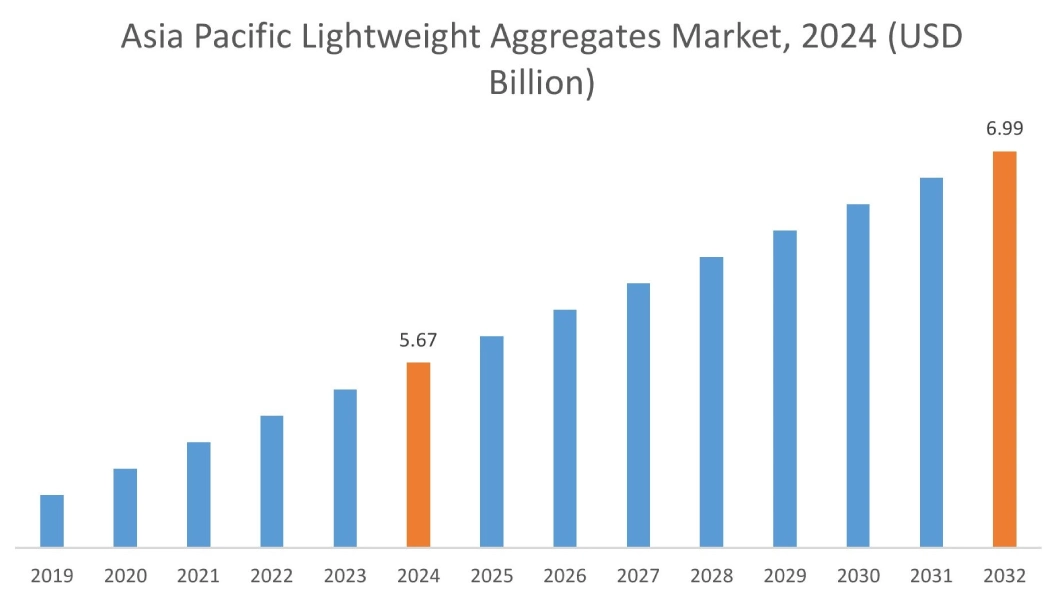
In 2024, Asia Pacific accounted for the highest lightweight aggregates market share at 42.13% and was valued at USD 5.67 Billion and is expected to reach USD 6.99 Billion in 2032. In Asia Pacific, China accounted for a market share of 40.47% during the base year of 2024. The APAC region is experiencing a substantial surge in residential construction projects. This is mainly fueled by rapid urbanization, increasing disposable incomes, and supportive government initiatives that are aimed at addressing growing housing requirements.
- For instance, according to Real Estate Japan, Japan’s new housing construction increased by 6.6% in year 2021 when compared to 2020.
Lightweight aggregates offer several benefits to residential builders. They enable the creation of lighter concrete and masonry units. This reduces the dead load on foundations and structural frames. This also translates into cost savings on materials, easier handling for construction crews, and potentially faster construction times. Overall, growing residential construction industry is driving the market in the region.
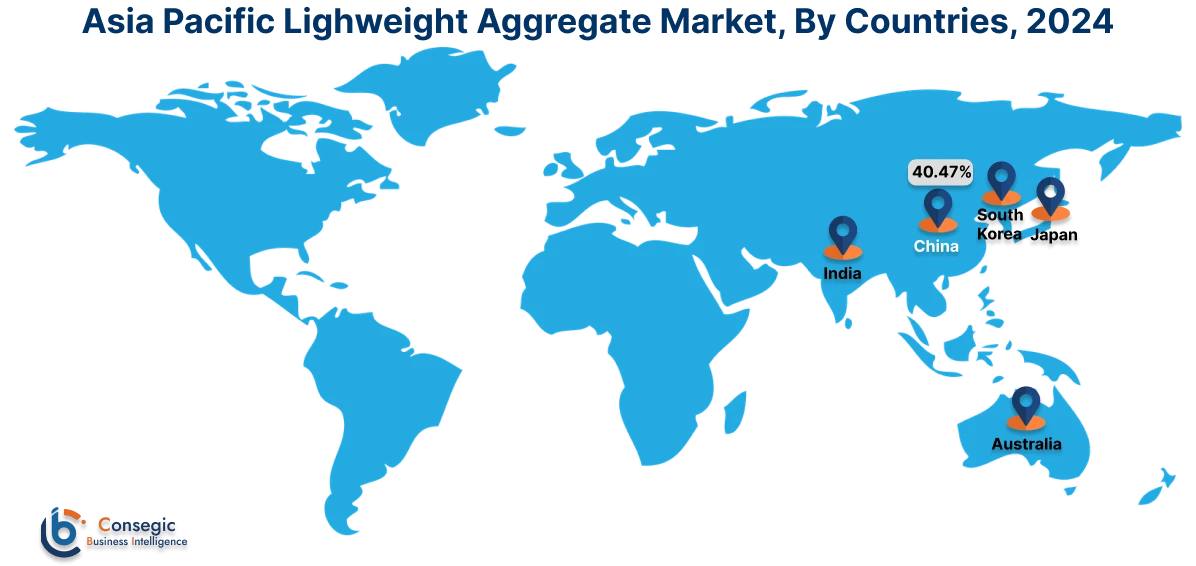
In North America, the lightweight aggregates market is experiencing the fastest growth with a CAGR of 4.4% over the forecast period. There are significant infrastructure development initiatives going on in the region. Both the United States and Canada are developing roads, bridges, public buildings, and utilities. Lightweight aggregate’s reduced density significantly lowers the dead load of concrete structures. It enables smaller, more economical foundations for bridges and elevated roadways. This leads to cost savings and faster construction. In areas with unstable soil, they improve geotechnical stability by reducing the load on the underlying ground that minimizes settlement. Furthermore, their use enhances seismic performance by decreasing inertial forces during earthquakes, making structures more resilient.
Europe lightweight aggregates market analysis indicates that several key trends are contributing to its growth in the region. The European Union's ambitious climate targets, exemplified by the European Green Deal and directives are driving the market as aggregates of lightweight nature enhance the thermal insulation properties of concrete and masonry. This leads to reduced energy consumption for heating and cooling buildings, thereby lowering operational carbon footprints. Moreover, when produced from recycled materials such as fly ash or expanded clay, they contribute to a circular economy, minimizing waste and the embodied carbon associated with new material extraction and production. Additionally, by improving concrete properties, they contribute to more durable structures. This reduces the need for premature repairs or replacements.
Middle East and Africa (MEA) lightweight aggregates market trend indicates that there is increasing adoption of aggregates of lightweight nature in disaster-resistant construction. In earthquake-prone zones, lighter structures experience reduced inertial forces during tremors. This leads to less stress on the building's frame and foundations. Lightweight concrete helps achieve this, making structures more stable and less prone to collapse. Moreover, in regions with extreme heat, these aggregates contribute to better thermal insulation and reduce the need for intensive cooling. This improves the energy efficiency and resilience of buildings against heat stress.
Latin America's region creates potential for the market analysis. The region is increasingly benefiting from trend of technological advancements in lightweight aggregates production. Advanced production technologies, such as optimized rotary kiln processes for expanded clay/shale (LECA/LECA), ensure more consistent aggregate properties such as strength, density, and porosity. This leads to more reliable and predictable performance in concrete and other applications. Moreover, innovations allow for the production of aggregates with tailored properties, such as improved thermal insulation, higher strength-to-weight ratios, or better fire resistance. This opens up new application possibilities in residential, commercial, and infrastructure projects across Latin America market trends.
Top Key Players and Market Share Insights:
The Global Lightweight Aggregates Market is highly competitive with major players providing products to the national and international markets. Key players are adopting several strategies in research and development (R&D) and product innovation to hold a strong position in the global Lightweight Aggregates market. Key players in the Lightweight Aggregates industry include
- Boral Limited (Australia)
- Charah Solutions (U.S.)
- Stalite Lightweight Aggregate (U.S.)
- Laterlite (Italy)
- LafargeHolcim (Switzerland)
- Buildex (U.S.)
- Arcosa (U.S.)
Lightweight Aggregates Market Report Insights :
| Report Attributes | Report Details |
| Study Timeline | 2019-2032 |
| Market Size in 2032 | USD 17.39 Billion |
| CAGR (2025-2032) | 3.3% |
| By Type |
|
| By End-Use |
|
| By Region |
|
| Key Players |
|
| North America | U.S. Canada Mexico |
| Europe | U.K. Germany France Spain Italy Russia Benelux Rest of Europe |
| APAC | China South Korea Japan India Australia ASEAN Rest of Asia-Pacific |
| Middle East and Africa | GCC Turkey South Africa Rest of MEA |
| LATAM | Brazil Argentina Chile Rest of LATAM |
| Report Coverage |
|
Key Questions Answered in the Report
How big is the Lightweight Aggregates market? +
In 2024, the Lightweight Aggregates market is USD 13.46 Billion.
Which is the fastest-growing region in the Lightweight Aggregates market? +
North America is the fastest-growing region in the Lightweight Aggregates market.
What specific segmentation details are covered in the Lightweight Aggregates market? +
By Type and End Use segmentation details are covered in the Lightweight Aggregates market.
Who are the major players in the Lightweight Aggregates market? +
Boral Limited (Australia), Charah Solutions (U.S.), LafargeHolcim (Switzerland), Buildex (U.S.), Arcosa (U.S.), Stalite Lightweight Aggregate (U.S.), Laterlite (Italy) are some of the major players in the market.
